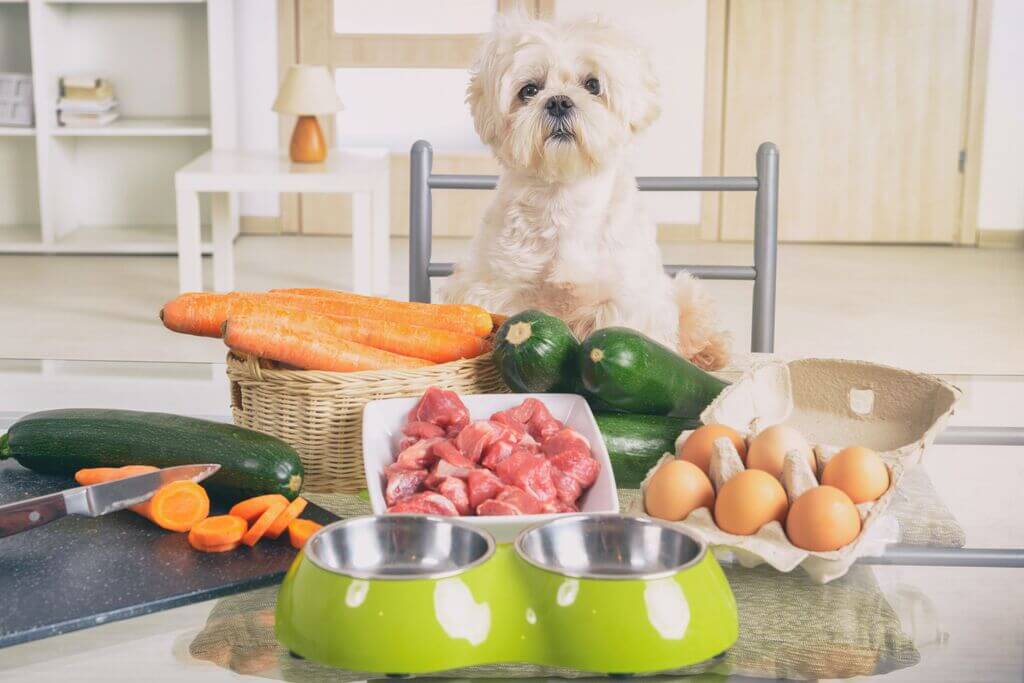
A dog food diet refers to the kind of food that is provided to dogs to satisfy their nutritional needs. It has various options of food that dogs consume to support their overall health and well-being. A dog’s diet is an important aspect of their care, as proper nutrition is important for maintaining their physical health and longevity.
Raw and cooked dog food diets are two multiple approaches to providing food to dogs. Different foods have distinct characteristics and benefits. However, they also come with considerations that need to be taken care of. Below, we will discuss raw vs. cooked dog food diets and explain their pros and cons in detail.
Raw Dog Food Diet:

The raw dog food diet for dachshunds includes predominantly raw meat and other uncooked ingredients. The psyche behind this diet is to copy the diet of a dog’s wild ancestors. People who support raw diets believe that raw foods provide more natural and biological nutrition.
Examples of Raw meat: Muscle meat, and protein sources like beef, chicken, lamb, and more.
Examples of Raw bones: Edible bones like chicken necks or backs.
Examples of Organ meats: liver, heart, and other organ meats for added nutritional value.
Examples of Fruits and vegetables: Some raw diets incorporate small amounts of raw fruits and vegetables for fiber and additional nutrients.
Pros of Raw Food Diet
Natural Nutrients: Advocates believe that raw diets mimic a dog’s Wild diet and provide them with the natural nutrients found in whole prey animals that they look for.
Dental Health: It is good for them to chew meat. Chewing raw meat, bones, and cartilage can assist in cleaning a dog’s teeth and promote better oral health.
Coat and Skin: People who advocate for a raw food diet claim that raw diets can lead to improved coat and skin quality and health due to the higher intake of healthy fats.
Allergies: Some dogs with food allergies or sensitivities can find relief on a raw diet, as it gets rid of certain additives and fillers found in commercial kibble.
Reduced Fillers: Raw diets heavily lack the fillers and preservatives commonly found in commercial dog food.
Cons of Raw Dog Food Diet
Pathogen Risk: Raw meat can essentially carry harmful bacteria like Salmonella. They could potentially lead to illness in dogs and pose a serious risk to human handlers.
Imbalance in Nutrition: If there is no careful planning, raw diets can very much lack essential nutrients. This can lead to deficiencies that affect a dog’s health.
Hazard of Bone: Consuming bones can result in choking or gastrointestinal obstruction if not handled correctly.
Handling Concerns: Handling raw meat can be messy and can require additional time and effort.
Digestive Issues: Some dogs can have difficulty adjusting to a raw diet. This can result in gastrointestinal issues.
Cooked Dog Food

Cooked dog food diets include preparing homemade meals using ingredients that are cooked. This can give more control over the ingredients and cooking process while lessening the risk of bacterial contamination. A cooked diet might include:
Cooked meats: chicken, turkey, lean beef, and fish.
Cooked vegetables: Carrots, spinach, sweet potatoes, and other dog-safe vegetables.
Grains: Brown rice or oats can provide carbohydrates.
Pros of Cooked Dog Food
Less Pathogen Risk: Cooking food gets rid of harmful bacteria. It makes it safer for both dogs and human companions.
Availability of Nutrients: Cooking can amplify the digestibility and availability of many nutrients. This can make it easier for dogs to absorb them.
Home-cooked food magic: Home-cooked diets allow for better control over ingredients. This helps in catering to a dog’s specific dietary needs.
Allergies: Cooked diets can assist in eliminating certain allergens.
Digestive Health: Some dogs with sensitive stomachs can tolerate cooked diets better than raw ones.
Cons of Cooked Dog Food
Loss of Nutrition: Cooking can lead to the lack of certain heat-sensitive nutrients. This is proven to be bad because it can reduce the overall nutritional value of the food.
Time issues: Preparing balanced cooked meals for dogs can be time-consuming. This job can expect from you careful planning to make sure of nutritional adequacy.
Money-consuming: High-quality ingredients for a cooked diet are expensive. This potentially increases the overall cost of feeding a dog.
Lack of Variety: Some homemade diets might lack variety, potentially leading to nutritional deficiencies over time.
Preservation: Cooked diets may have a shorter shelf life and can require freezing.
It’s important to understand that proper research, and consultation with an animal nutritionist are crucial to ensure that your dog’s diet is balanced. Keep in mind that what might work well for one dog might not work for another. Hence, individual preferences and dietary requirements should be taken into consideration when choosing a diet for your dog.
While we have mentioned raw and cooked food, let’s not forget to mention canned food as well. Canned also called wet dog food contains higher moisture content as compared to dry kibble. Dry Kibble is an easy-to-store diet that can served quickly. This can be of great benefit to dogs that don’t drink enough water. It also contains more meat and fewer carbohydrates. It helps provide a more natural diet for some dogs.
The major benefit of this food is that it has a higher moisture content and is more palatable for some dogs. Hence, less processed food for dogs. Its bad effect is in its short shelf life. It is also more expensive than dry kibble.
Conclusion
In this article, we have extensively explained raw dog food vs. cooked dog food. We have briefly mentioned the benefits these foods can provide to dogs. Additionally, through multiple examples, we have shown you a picture of how these foods can affect a dog’s health. Moreover, we have mentioned detailed pros and cons of both kinds of foods so you can have a clear perception of dog foods.
In Case You Missed it!











